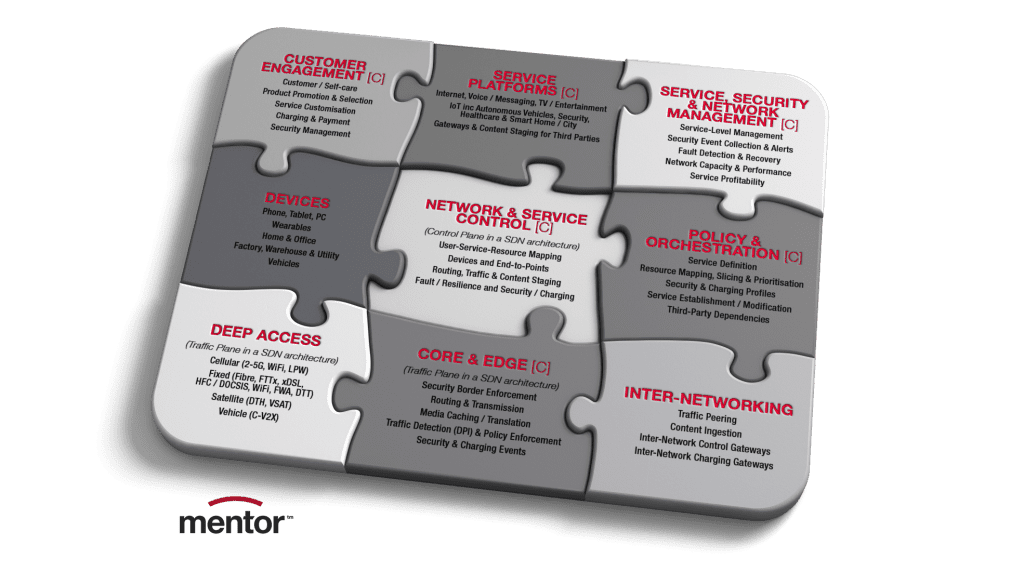Implementing 5G: How SDN/NFV is driving the future of networking
SDN and NFV – shaking up network architectures
Mentor’s 5G technology jigsaw is a simple but effective representation of the major inter-relationships between the different components of the technology platform in a telco business.
The next piece of the puzzle refers to Software Defined Networks (SDN) and Network Function Virtualisation (NFV).
You’ve probably heard these phrases bandied around – but you may not understand what they really mean and what the implications are for your telco.
SDN impacts 3 weighty Jigsaw pieces – The Control Plane to Network & Service Control – the Traffic Plane to Deep Access – and also to Core & Edge.
Virtualisaton, of course, applies to many of the Jigsaw pieces that are able to take advantage of Cloud technology.
But NFV, primarily applies to Deep Access and to Core & Edge.
Mentor’s 5G Technology Platform
 [C] – major opportunities for ‘Cloud’ centralisation and virtualisation
[C] – major opportunities for ‘Cloud’ centralisation and virtualisation
What is Software Defined Networking?
‘Ground-breaking transformation’ is now a hackneyed cliché. But core networks have changed out of all recognition.
And there are two irresistible technological forces that have shaped this change.
There was a time when we had plenty of core networks. The phone network, intelligent networks, Kilostream, X25, Frame Relay, ATM, GSM – and so on.
All these networks had a narrow purpose – but did a good job. They were built from bespoke hardware and software – usually from a single vendor.
The first irresistible force is the Internet. Specifically, the omnipresent Internet Protocol (IP).
The core fabric of all these networks – and the new ones needed for the Internet – grew towards a much simpler architecture. They all included very high-speed IP routers, interconnected with optical fibre.
Many of those legacy networks have just faded away – as designers added ‘smarts’ to IP networks to mimic the legacy network’s purpose – and many new ones.
This highlights the first of the new acronyms – SDN, or Software Defined Networks.
The heart of the SDN concept is the separation of the data plane – and the control plane. Think of it as a bit like the difference between railway tracks and railway signalling.
SDN separates the ‘smarts’ that define the specific purpose of the network from the routers and transmission – whose job was to ship data packets around the network, as fast as possible.
So, whether you are building a network for broadband Internet, Wi-Fi, advanced mobile or TV – the engineers will think in these terms – and design networks using these two planes.
The second irresistible force is the relentless improvement in the price/performance of computing kit – driven by Moore’s law, amongst other things.
All this IP networking kit – whether for the data or control planes – was made from specialist networking hardware with built-in software.
The usual suspects, Cisco and Juniper, did very well out of these products and were able to expand into many other adjacent segments from their strong IP base.
What is Network Function Virtualisation?
NFV – or Network Function Virtualisation – is the marriage of the ‘control plane’ functions and commodity commercial computing.
Many vendors realised that complex control plane functions could be simplified with much more powerful software development tools – and ‘elastic’ computing resources – provided by the type of computer hardware and software usually found in massive data centres.
This allowed vendors and telcos to offer many network solutions using a single network fabric – independent of the network’s purpose – and the opportunity for much more robust control functions, under a consistent end-to-end network management system running on commercial ‘blade servers.’
Imagine how exciting this is to a telco management team, liberated from the necessity to buy all network components from one vendor.
Instead, they could buy commodity computing hardware, ‘mixing and matching’ network-function software on top, from the leading suppliers.
At last, they can escape from vendor catalogues and roadmaps – with their bespoke hardware and software bundled into a seductive product portfolio – and unattractive price lists.
The benefits of SDN / NFV
In practice, all the leading vendors are taking SDN and NFV technologies on board for their own product portfolios.
When it’s deployed, it will deliver benefits to telco customers, in terms of price/performance for the equipment and operational reliability. And the manageability of services built from it.
For instance, the new mobile architecture for 5G simply ‘assumes’ the use SDN/NFV technologies.
Leading telcos like AT&T are strong proponents of the technology with their “White Box Network” initiative.
There are efforts to create standards to allow even more ‘mixing and matching’ of components from different vendors – such as OpenFlow and Open RAN. But there’s lukewarm support from vendors, so far.
Telco customers can’t avoid these technologies – and indeed shouldn’t – because there are numerous benefits, in terms of price performance and operational effectiveness.
Everyone should keep pushing for standards adoption – and be open to multi-vendor possibilities – because of the flexibility and leverage it could provide.
But don’t rely on that happening anytime soon.
In practice, the trend for telcos to outsource network ‘stuff’ to vendors – whether it’s design, build, real-time operations (or all of these) – works against a multi-vendor breakthrough.
We all prefer to innovate and differentiate as we struggle against forces that commoditise our products – whether from a vendor or an operator.
Vendors will quite rationally resist taking responsibility for the headache of integrating different vendor hardware or software into their systems – simply because this also reduces sales volumes and puts pressure on their pricing.
What does SDN / NFV mean for 5G?
Well, the new emerging architectures for 5G and Full fibre just assume SDN/NFV technology in their core.
We will all be moving towards this technology. This is good because the technology is sound, on the whole.
We can look forward to heaps of capacity in the control plane, more robust software and highly effective management capabilities enabled by AI, in the not very distant future.
All of this is possible now.
But let’s be careful what we wish for with multi-vendor mix and match. We don’t have enough standards yet, never mind vendor support for the standards we already have.
Even when we do – an unwise choice of one system component could massively complicate your integration program and really water down delivery accountabilities – with all of the predictable hassle that goes with that.

